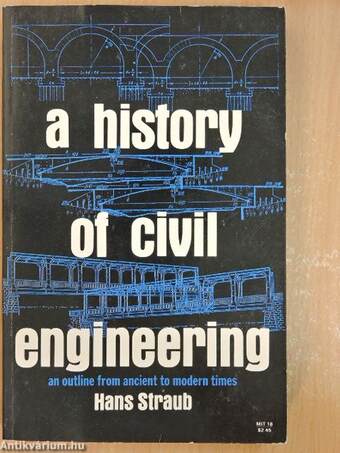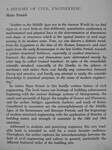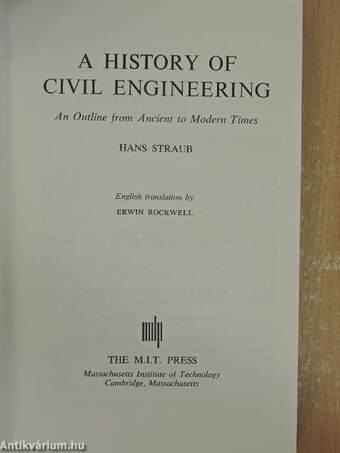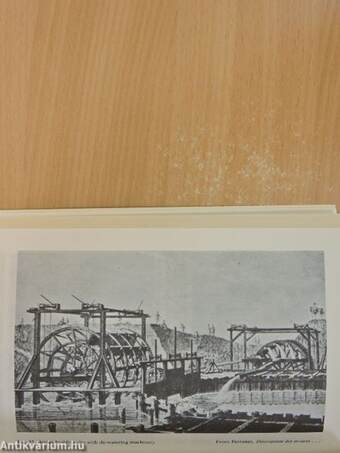1.067.715
kiadvánnyal nyújtjuk Magyarország legnagyobb antikvár könyv-kínálatát

VISSZA
A TETEJÉRE
JAVASLATOKÉszre-
vételek
A History of Civil Engineering
An Outline from Ancient to Modern Times
| Kiadó: | The M. I. T. Press |
|---|---|
| Kiadás helye: | Cambridge |
| Kiadás éve: | |
| Kötés típusa: | Ragasztott papírkötés |
| Oldalszám: | 258 oldal |
| Sorozatcím: | |
| Kötetszám: | |
| Nyelv: | Angol |
| Méret: | 20 cm x 13 cm |
| ISBN: | |
| Megjegyzés: | Fekete-fehér fotókkal, illusztrációkkal. |
naponta értesítjük a beérkező friss
kiadványokról
naponta értesítjük a beérkező friss
kiadványokról
Fülszöveg
A HISTORY OF CIVIL ENGINEERING Hans Straub "Neither in the Middle Ages nor in the Ancient World do ive find signs of, or even hints at, that deliberate, quantitative application of mathematical and phijsical laxvs to the determiruition of dimensions and shape of structures which is the typical feature of civil engineering in its modern sense. True, we can discern a definite trend, w from the Egyptians to the time of the Román Emperors, and once again from the early Romanesque to the late Gothic Period, towards a greater structural 'boldness', especially of vaulted structures. . . . however, the shapes and dimensions were determined merely by what may be called 'trained intuition. In spite of the remarkable scientific standard, especially of the Greeks, in the spheres of mechanics and statics there was hardly any connection between theory and practice, and hardly any attempt to apply the scientific knowledge to practical purposes, in the sense of modern engineering." So writes Hans... TovábbFülszöveg
A HISTORY OF CIVIL ENGINEERING Hans Straub "Neither in the Middle Ages nor in the Ancient World do ive find signs of, or even hints at, that deliberate, quantitative application of mathematical and phijsical laxvs to the determiruition of dimensions and shape of structures which is the typical feature of civil engineering in its modern sense. True, we can discern a definite trend, w from the Egyptians to the time of the Román Emperors, and once again from the early Romanesque to the late Gothic Period, towards a greater structural 'boldness', especially of vaulted structures. . . . however, the shapes and dimensions were determined merely by what may be called 'trained intuition. In spite of the remarkable scientific standard, especially of the Greeks, in the spheres of mechanics and statics there was hardly any connection between theory and practice, and hardly any attempt to apply the scientific knowledge to practical purposes, in the sense of modern engineering." So writes Hans Straub in this lucidly written history of civil engineering. The book traces our heritage of building achievement beginning with the ancient drainage systems of Mesopotamia, the canals and pyramids of Egypt, the temples of Greece and Phoenicia, and the arches, bridges, aqueducts, harbors, and roads of Rome. Considered in succession are the accomplishments of the Middle Ages, of the Renaissance and Baroque Periods, and the beginnings of modern structural engineering with the application of theories of building statics and strength of materials in the 18th and 19th centuries. Addressed to students and practicing engineers, this very readable book is intended as well for a much broader audience. Throughout, the author explores the interrelationships between the field of civil engineering and culture in generál, particularly the different historical styles of the building arts. VisszaTémakörök
Hans Straub
Hans Straub műveinek az Antikvarium.hu-n kapható vagy előjegyezhető listáját itt tekintheti meg: Hans Straub könyvek, művekMegvásárolható példányok
Nincs megvásárolható példány
A könyv összes megrendelhető példánya elfogyott. Ha kívánja, előjegyezheti a könyvet, és amint a könyv egy újabb példánya elérhető lesz, értesítjük.










